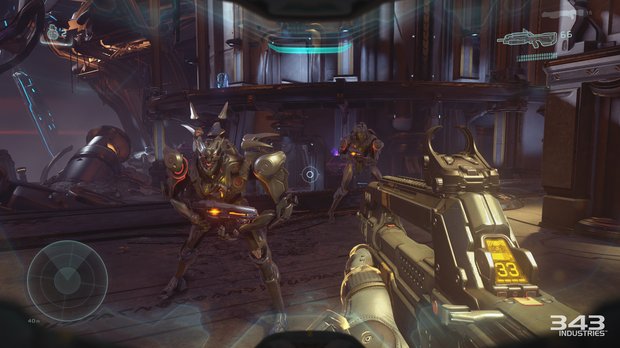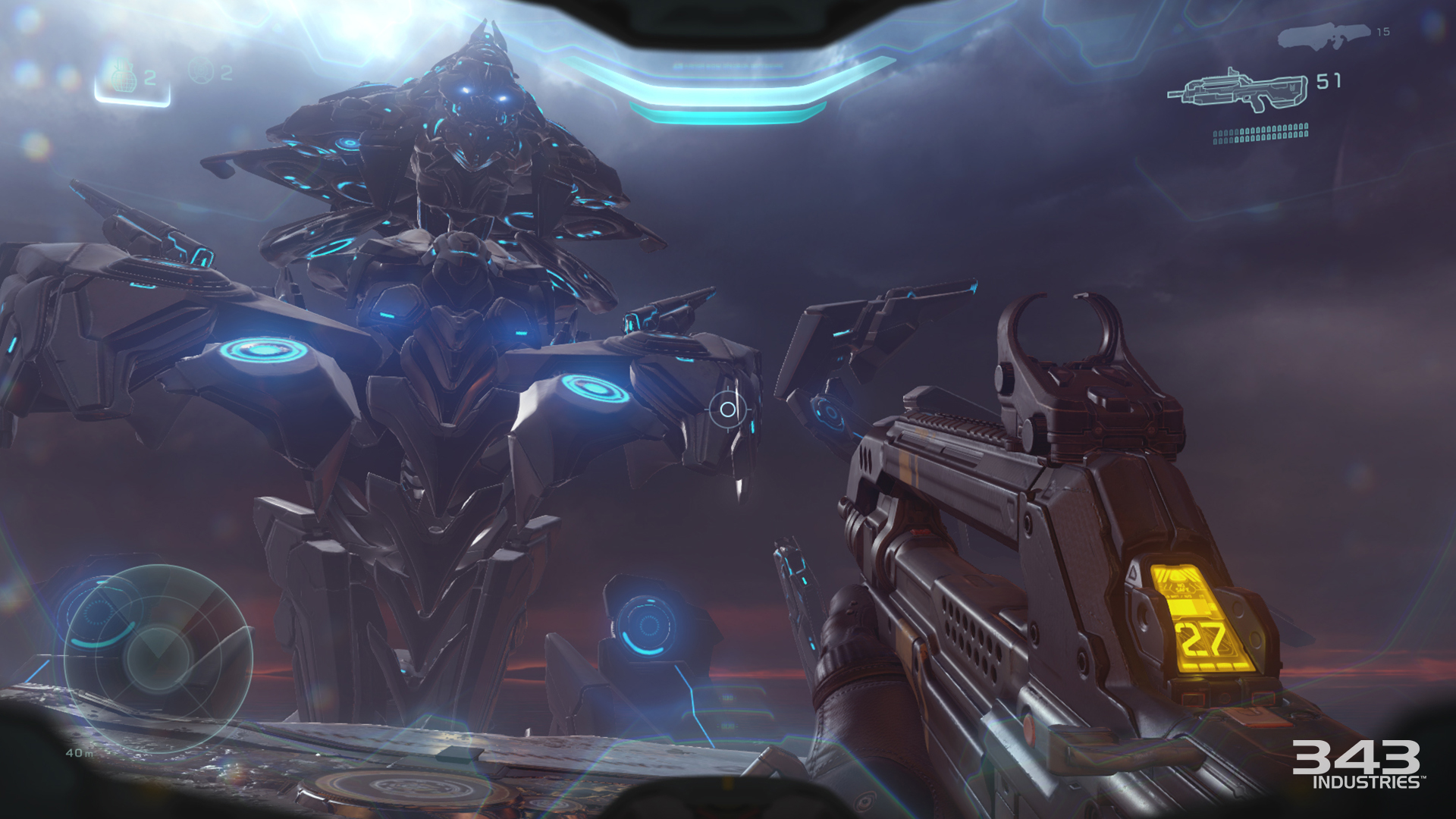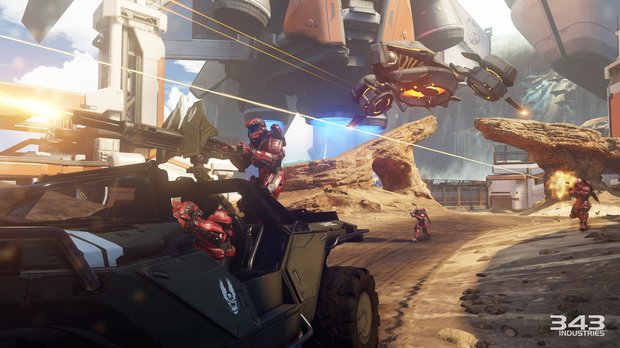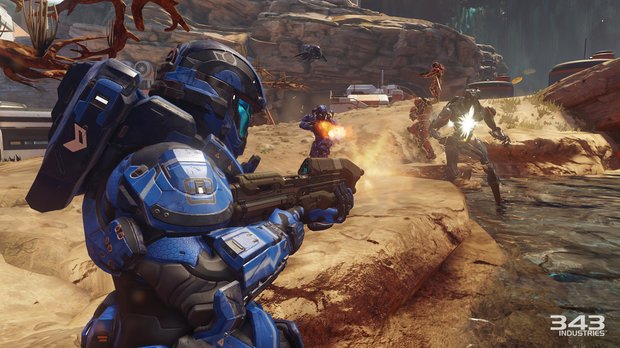There was a trailer at E3 that had me scrambling for the sickbag. A trailer so sick and subversive that it made my stomach churn a little bit. Nope, not Doom; I'm talking about the campaign reveal of Halo 5: Guardians.
Coming in to E3, there were already concerns amongst some Halo fans that 343 Industries was steering the series into becoming more like Activision's Call of Duty series. This feeling stemmed from some of the divisive changes introduced during last December's Halo 5 multiplayer beta, such as the introduction of things such as Smart-linking which is, in effect, Call of Duty's Aim Down Sights (ADS).

A chat I had with Josh Holmes, Halo 5 Studio head, last February did much to quell these suspicions for me; he talked long and openly about how his team is making physical alterations to the maps playable in the beta, as he felt some of them were too wide open with too many points of entry. Which is an interesting observation to make, as wide-open maps with multiple entry points are one of Call of Duty's calling cards.
“The main difference between Halo and Call of Duty is that in Halo, when you're shot, you have the ability to turn around and fight back” Holmes explained to me at the time for Official Xbox Magazine. “We want to give players better ability to control a zone, and that means not giving them more entrance points than can be reasonably controlled”.
Those are all the right words, but perception can be a tricky thing to shift. And the Halo 5: Guardians campaign gameplayer trailer 'Battle of Sunaion', which kickstarted Microsoft's E3 Conference, was to that perception what cold water is to an electrical fire.

The trailer sees Agent Locke and Fireteam Osiris scuttle through the titular alien city, as part of their ongoing search for The Master Chief, who's done a runner. I won't give you a blow for blow account of the trailer, as you can watch the thing in its entirety here, but it doesn't take a trained eye to spot that things are a little...off.
It isn't the fact that the level design is basically one big linear corridor that concerns me – Halo might be at its best when it blows the level design wide open, but even the best entries in the series allow themselves to be slaves to the narrative once in a while. What should be a wider concern is what the demo mistakes for drama – a spaceship exploding in the distance, a pathway crumbling beneath Locke's feet, a seemingly impassible Promethean warship that is bypassed not by cunning but by flaccidly giving the orders to one of your teammates to lay down fire. Basically you're trained to have your eyes fixed anywhere but on the action. It's the same set of parlour tricks we've come to associate with Call of Duty, and frankly speaking that’s not what I'm looking for in a Halo game.
Weekly digests, tales from the communities you love, and more
For clarity's sake, I should point out that I like Call of Duty. But it does what it does so well, and what it does is so limited in scope, that I really have no desire to see other studios do a bad cover version of it, when their talents lie in making other, different things.

'So you can appreciate why the Halo 5 trailer made me do a scream in my mouth. Particularly as the ethos of Call of Duty and Halo are so intrinsically different. The former likes to build excitement through theatrics, carefully-managed set-pieces and Hollywood bombast. Halo favours a more emergent, cerebral sandbox style of play, where the theatrics come not from fireworks but from the gunplay itself.
It's not just one thing that makes a Halo game a Halo game – it's everything – the finely-balanced spread of weapons, vehicles and enemy types, and how the interplay between these things allows the designers to remix the action simply by plugging in and out different toys from their extensive toybox.
There's a famous quote from Jamie Griesemer, a designer who worked on the first three Halo games, that describes Halo as '30 seconds of fun, over and over again'. But taken out of context, Griesemer's quote doesn't really get across what he was getting at. Really if you think about it, all you do in your average Halo campaign mission is lurch from skirmish to skirmish – the same 30 seconds of fun, if you will – but no two sections ever feel the same, such is the wealth of options Halo has at its disposal to throw at the player, and such are the tactical options the wide-open playing spaces give the player to throw back at the game.

The campaign trailer displays little of this. New Promethean soldiers and warships whet the appetite – the more toys for the toybox, the merrier – but the context they are placed in certainly does not. Take the Doom trailer we mentioned in passing at the beginning as a comparable; the gore might not be to everyone’s tastes, but, it is unmistakably coded as a Doom game – from the meaty shotguns, to the fast, whirling combat, to the art style, to the brief BFG cameo, it is everything you could reasonably expect a modern Doom game to be.
So is the Battle of Sunaion representative of the entire campaign? Is Call of Duty influencing Halo 5's design more than we'd like? I asked exactly that question to Chris Lee, Lead Producer:
“I would say for the E3 keynote demo that some of the destruction and chaos that was going on in the mission was intended to be indicative of a specific design principle where we want to create more options and more flexibility for the player when they play through the spaces.
“With the tracking system, the player can be dropped into much larger playing spaces with multiple different ways of acheving the objective with your squad. Throughout the campaign, as you progress, you'll actually get more and more of these larger spaces that we were only able to build when we moved to dedicated servers on Xbox One. You didn't really get to see that in the demo, but that is definitely something you'll see”.

Promising – as with Josh Holmes, all the noises coming out of 343 Industries are the right ones – but the proof is in the playing. And that is where my hands-on with Warzone, Halo 5's epic-scale, 12 v 12 multiplayer mode, did much to make me a believer. It's difficult, of course, to extrapolate too much about a campaign mode from its tag-along multiplayer, but that's not taking into account what Warzone's mission objective is – in 343's own words, it's an attempt to smush everything that is good about Halo into one, catch-all multiplayer mode.
That means player v. player, but it also means player v. AI. It means that every toy in the toybox gets to comes out to play. Only this time you get the keys to the box; points earned during combat can be traded in at requisition stations for weapons and vehicles of your own choosing.
343 Industries still gets to play designer, of course – enemy waves are carefully stage-managed, even if they don't necessarily run by clockwork. But by giving players the agency to work towards their weapons of choice, they create a battlefield which has a very natural, very exciting sense of escalation. And it's all staged in a vast environment, filled with with small pockets of carefully-crafted design that allow the same exhilarating sense of tactical freedom that Bungie's works provide at their best.

So actually, if you shared my concerns about the Halo trailer – and a cursory glance at social media reminds me that, mercifully, I haven't just made it all up in my head – then be soothed by the news that both the words 343 Industries speaks, and the clever, sandbox-oriented design of Warzone, sing of a studio that's fully in tune with Halo's unique rhythm, having hit the occasional bum note with Halo 4.
I could be wrong, of course, and the sandbox stuff could be restricted to its Warzone ghetto while the single-player mode goes full Captain Price in Halo's quest to remain ‘culturally relevant’. But I no longer fear that's the case at all. Delving deeper into Halo 5's design served as a timely reminder that at E3, with dozens of loud, bright trailers bouncing around the cauldron, competing for eyes and ears, seeing isn't always believing – for better and for worse.



